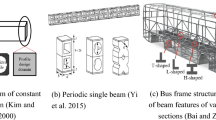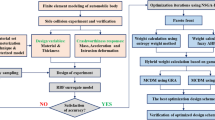Abstract
To increase the range of applicability of decoupling strategies for reliability-based design optimization (RBDO), a sequential optimization and moment-based reliability assessment (SOMRA) is proposed. In this approach, a moment method based on the univariate dimension reduction method (UDRM) and probability density function (PDF) estimation is employed. Meanwhile, a corresponding mathematical model and a PDF-based method of calculating the shifting scalar are developed to decouple the reliability assessment from the optimization process. The shifting scalar is corrected according to the nonlinear degree of the limit state surface of the performance function before reconstructing the mathematical model for the next iteration of optimization. This approach uses statistical moments to check whether the constraints are active, and rather than assessing the reliability and calculating the shifting scalars for all constraints, only the active constraints are considered for the PDF estimation and shifting scalar calculation. Three numerical examples and an automobile crashworthiness lightweight design problem are presented to demonstrate the effectiveness of the proposed method.













Similar content being viewed by others
References
Acar E, Rohani MR, Eamon CD (2010) Reliability estimation using univariate dimension reduction and extended generalised lambda distribution. Int J Reliab Saf 4(2/3):166
Agarwal H, Mozumder CK, Renaud JE et al (2008) An inverse-measure-based unilevel architecture for reliability-based design optimization. Struct Multidiscip Optim 33(3):217–227
Barndorff-Nielsen O, Cox DR (1979) Edgeworth and saddle-point approximations with statistical applications. J R Stat Soc Ser B Methodol 41:279–312
Basudhar A, Missoum S (2008) Adaptive explicit decision functions for probabilistic design and optimization using support vector machines. Comput Struct 86:1904–1917
Bichon BJ, Eldred MS, Swiler LP et al (2008) Efficient global reliability analysis for nonlinear implicit performance functions. AIAA J 46(10):2459–2468
Chen Z, Qiu H, Gao L et al (2013a) An optimal shifting vector approach for efficient probabilistic design. Struct Multidiscip Optim 47(6):905–920
Chen Z, Qiu H, Gao L et al (2013b) An adaptive decoupling approach for reliability-based design optimization. Comput Struct 117:58–66
Chen Z, Qiu H, Gao L et al (2014) A local adaptive sampling method for reliability-based design optimization using kriging model. Struct Multidiscip Optim 49(3):401–416
Cheng GD, Xu L, Jiang L (2006) A sequential approximate programming strategy for reliability-based structural optimization. Comput Struct 84(21):1353–1367
Cho TM, Lee BC (2011) Reliability-based design optimization using convex linearization and sequential optimization and reliability assessment method. Struct Saf 33(1):42–50
Dai YS, Xie M, Long Q et al (2008) Uncertainty analysis in software reliability modeling by bayesian analysis with maximum-eneliability-based design optimization using a moment method and a kriging metamodel. Eng Optim 40(5):421–438
Dai HZ, Zhao W, Wang W (2011) An improved radial basis function network for structural reliability analysis. J Mech Sci Technol 25(9):2151–2159
Du XP (2008) Saddlepoint approximation for sequential optimization and reliability analysis. J Mech Des 130(1):1–36
Du XP, Chen W (2003) Sequential optimization and reliability assessment method for efficient probabilistic design. J Mech Des 126(2):871–880
Ho-Huu V, Duong-Gia D, Vo-Duy T et al (2018) An efficient combination of multi-objective evolutionary optimization and reliability analysis for reliability-based design optimization of truss structures. Expert Syst Appl 102:262–272
Hu C, Youn BD (2011) Adaptive-sparse polynomial chaos expansion for reliability analysis and design of complex engineering systems. Struct Multidiscip Optim 43(3):419–442
Huang B, Du XP (2006) Uncertainty analysis by dimension reduction integration and saddlepoint approximations. J Mech Des 128(1):26–33
Huang HZ, Zhang XD, Liu Y (2012) Enhanced sequential optimization and reliability assessment for reliability-based design optimization. J Mech Sci Technol 26(7):2039–2043
Huang ZL, Jiang C, Zhou YS et al (2016) An incremental shifting vector approach for reliability-based design optimization. Struct Multidiscip Optim 53(3):523–543
Jiang C, Deng SL (2014) Multi-objective optimization and design considering automotive high-speed and low-speed crashworthiness. Chin J Comp Mech 31(4):474–479
Ju BH, Lee BC, Rasudhar A et al (2008) Adaptive explicit decision functions for probabilistic design and optimization using support vector machines. Comput Struct 86(19–20):1904–1917
Lee TH, Jung JJ (2008) A sampling technique enhancing accuracy and efficiency of metamodel-based RBDO: constraint boundary sampling. Comput Struct 86(13):1463–1476
Lee JJ, Lee BC (2005) Efficient evaluation of probabilistic constraints using an envelope function. Eng Optim 37(2):185–200
Lee I, Choi KK, Du L et al (2008) Inverse analysis method using MPP-based dimension reduction for reliability-based design optimization of nonlinear and multi-dimensional systems. Comput Methods Appl Mech Eng 198(1):14–27
Li G, Zhang K (2011) A combined reliability analysis approach with dimension reduction method and maximum entropy method. Struct Multidiscip Optim 43(1):121–134
Li X, Qiu H, Chen Z et al (2016) A local kriging approximation method using MPP for reliability-based design optimization. Comput Struct 162:102–115
Liang J, Mourelatos ZP, Tu J (2004) A single-loop method for reliability-based design optimization.//ASME 2004 International Design Engineering Technical Conferences and Computers and Information in Engineering Conference. American Society of Mechanical Engineers
Liao KW, Ivan G (2014) A single loop reliability-based design optimization using EPM and MPP-based PSO. Latin Am J Solids Struct 11(5):826–847
Liu J, Meng XH, Xu C et al (2018) Forward and inverse structural uncertainty propagations under stochastic variables with arbitrary probability distributions. Comput Methods Appl Mech Eng 342:287–320
Lu C, Feng YW, Liem RP et al (2018) Improved kriging with extremum response surface method for structural dynamic reliability and sensitivity analyses. Aerosp Sci Technol 76:164–175
Lv XJ, Gu XG, Wang GR et al (2016) Reliability optimization on pedestrian flexible legform impact based on ensemble of metamodel. J Mech Eng 52(10):142–149
Meng GW, Feng XY, Li F et al (2016) Structural reliability analysis based on dimensionality reduction and Edgeworth series. J Beijing Univ Aeronaut Astronaut 42(3):421–425
Meng Z, Zhang DQ, Liu ZT et al (2018) An adaptive directional boundary sampling method for efficient reliability-based design optimization. J Mech Des 140(12):121406
Meng Z, Zhang DQ, Li G et al (2019) An importance learning method for non-probabilistic reliability analysis and optimization. Struct Multidiscip Optim 59:1255–1271
Nagahara Y (2004) A method of simulating multivariate nonnormal distributions by the Pearson distribution system and estimation. Comp Statistics Data Anal 47(1):1–29
Rahman S, Xu H (2004) A univariate dimension-reduction method for multi-dimensional integration in stochastic mechanics. Prob Eng Mech 19(4):393–408
Rosenblatt M (1952) Remarks on a multivariate transformation. Ann Math Stat 23(3):470–472
Shan S, Wang GG (2008) Reliable design space and complete single-loop reliability-based design optimization. Reliab Eng Syst Saf 93(8):1218–1230
Wang X, Wang R, Wang L et al (2018) An efficient single-loop strategy for reliability-based multidisciplinary design optimization under non-probabilistic set theory. Aerosp Sci Technol 73:148–163
Wu YT, Wang W (1996) Efficient probabilistic design by converting reliability constraints to equivalent approximate deterministic constraints. Integr Des Process Technol 2(4):13–21
Zellner A, Highfield RA (1988) Calculation of maximum entropy distributions and approximation of marginalposterior distributions. J Econ 37(2):195–209
Zhang XF, Pandey MD, Zhang YM (2011) A numerical method for structural uncertainty response computation. Sci China Technol Sci 54(12):3347–3357
Zhang DQ, Han X, Jiang C et al (2017) Time-dependent reliability analysis through response surface method. J Mech Des 139(4):041404
Zhao L, Choi KK, Lee I, et al (2009) Response surface method using sequential sampling for reliability-based design optimization.//ASME 2009 International Design Engineering Technical Conferences and Computers and Information in Engineering Conference. American Society of Mechanical Engineers
Data availability statement
The datasets generated and/or analyzed during the current study are available from the corresponding author upon reasonable request.
Funding
This study was funded by the National Natural Science Foundation of China (No. U1664252) and the National Key Research and Development Program of China (No. 2016YFB0101700).
Author information
Authors and Affiliations
Corresponding author
Ethics declarations
Conflict of interest
The authors declare that they have no conflict of interest.
Replication of results
The corresponding codes can be obtained in the supplementary material. Only the codes for numerical example 1.1 are given because differences exist only for the functions of constraints and objections.
Figures 1 and 3 are created with Microsoft Visio 2013. Figures 2 and 10 are created with AutoCAD 2014. Figures 4, 5, 6, 7, 8, 9, 11, and 13 are created with Origin9.0. Figure 12 is created with HyperView14.0.
Additional information
Responsible Editor: Mehmet Polat Saka
Publisher’s note
Springer Nature remains neutral with regard to jurisdictional claims in published maps and institutional affiliations.
Rights and permissions
About this article
Cite this article
Wang, Z., Li, H., Chen, Z. et al. Sequential optimization and moment-based method for efficient probabilistic design. Struct Multidisc Optim 62, 387–404 (2020). https://doi.org/10.1007/s00158-020-02494-7
Received:
Revised:
Accepted:
Published:
Issue Date:
DOI: https://doi.org/10.1007/s00158-020-02494-7




